Structural Parameter Optimization of the Helical Blade of the Variable-Pitch, Downhole, Cyclone Separator Based on the Response Surface Method
Abstract
:1. Introduction
2. Methods
2.1. Model Design
2.2. Validation
2.3. Numerical Simulation Method
2.3.1. The Basic Principle of the Response Surface Method
2.3.2. Mathematical Model
- (1)
- Liquid phase control equation
- (2)
- Control equation of particle phase
2.3.3. Force of Sand in the Downhole Cyclone Separator
2.3.4. Parameter Settings and Boundary Conditions
3. Results and Discussion
3.1. CCD Experimental Design and Equation Construction
3.2. Analysis of Variance
3.3. Optimization Results and Verification
3.4. Verification and Discussion of Optimization Results by CFD
3.5. Comparison of Separation Performance
4. Conclusions
- (1)
- In this paper, the separation efficiency and pressure drop of the new three-stage variable pitch are numerically simulated by CFD-Fluent 2021 R2 software, and the optimal three-stage variable pitch size is optimized by the response surface method. Finally, the numerical simulation and the experimental results are verified. The separation efficiency of the optimized structure was verified by response surface methodology.
- (2)
- Through local sensitivity analysis, it is concluded that among the parameters of the first-stage pitch x1, the second-stage pitch x2, and the third-stage pitch x3 parameters of the variable pitch cyclone separator, the sensitivity of the influence on the sediment concentration in the bottom flow outlet is from the largest to the largest. The order to the smallest is x3 > x2 > x1.
- (3)
- It is feasible to construct the mathematical model between the structural parameters, separation efficiency, and underflow pressure loss by using the center combination design (CCD) experimental design method of the response surface. The correlation coefficient of the separation efficiency prediction model based on the second-order polynomial was 0.8979, and the correlation coefficient of the underflow pressure loss prediction model was 0.9326. The analysis of variance results verified that the model has good significance and high precision.
- (4)
- The numerical simulation is in good agreement with the model prediction results. After optimization, the separation efficiency of the cyclone structure is all above 98%, and the separation efficiency increases by more than 8%, which fully shows that the model has better performance and high feasibility.
Author Contributions
Funding
Institutional Review Board Statement
Informed Consent Statement
Data Availability Statement
Conflicts of Interest
References
- Pan, Z.; Wu, Y.; Shang, L.; Zhou, L.; Zhang, Z. Progress in use of surfactant in nearly static conditions in natural gas hydrate formation. Front. Energy 2020, 14, 463–481. [Google Scholar] [CrossRef]
- Ruan, X.; Li, X.-S.; Xu, C.-G. A review of numerical research on gas production from natural gas hydrates in China. J. Nat. Gas Sci. Eng. 2021, 85, 103713. [Google Scholar] [CrossRef]
- Sun, H.; Chen, B.; Yang, M. Effect of multiphase flow on natural gas hydrate production in marine sediment. J. Nat. Gas Sci. Eng. 2020, 73, 103066. [Google Scholar] [CrossRef]
- Gambelli, A.M.; Tinivella, U.; Giovannetti, R.; Castellani, B.; Giustiniani, M.; Rossi, A.; Zannotti, M.; Rossi, F. Observation of the Main Natural Parameters Influencing the Formation of Gas Hydrates. Energies 2021, 14, 1803. [Google Scholar] [CrossRef]
- Guo, K.; Fan, S.; Wang, Y.; Lang, X.; Zhang, W.; Li, Y. Physical and chemical characteristics analysis of hydrate samples from northern South China sea. J. Nat. Gas Sci. Eng. 2020, 81, 103476. [Google Scholar] [CrossRef]
- Li, B.; Chen, L.-L.; Wan, Q.-C.; Han, X.; Wu, Y.-Q.; Luo, Y.-J. Experimental study of frozen gas hydrate decomposition towards gas recovery from permafrost hydrate deposits below freezing point. Fuel 2020, 280, 103476. [Google Scholar] [CrossRef]
- Roque Lima, M.D.; Santos Patricio, E.P.; Barros Junior, U.d.O.; de Assis, M.R.; Xavier, C.N.; Bufalino, L.; Trugilho, P.F.; Gherardi Hein, P.R.; Protasio, T.d.P. Logging wastes from sustainable forest management as alternative fuels for thermochemical conversion systems in Brazilian Amazon. Biomass Bioenergy 2020, 140, 105660. [Google Scholar] [CrossRef]
- Wang, J.; He, J.; Lv, X.; Ge, K.; Cheng, C.; Dong, H. Numerical analysis of the gas recovery performance in hydrate reservoirs with various parameters by stepwise depressurization. J. Pet. Sci. Eng. 2021, 203, 108670. [Google Scholar] [CrossRef]
- Zhang, H.; Bi, J.; Luo, X. Oedometer test of natural gas hydrate-bearing sands: Particle-scale simulation. J. Nat. Gas Sci. Eng. 2020, 84, 103631. [Google Scholar] [CrossRef]
- Zhang, S.-W.; Shang, L.-Y.; Zhou, L.; Lv, Z.-B. Hydrate Deposition Model and Flow Assurance Technology in Gas-Dominant Pipeline Transportation Systems: A Review. Energy Fuels 2022, 36, 1747–1775. [Google Scholar] [CrossRef]
- Jiang, L.; Xu, N.; Liu, Q.; Cheng, Z.; Liu, Y.; Zhao, J. Review of Morphology Studies on Gas Hydrate Formation for Hydrate-Based Technology. Cryst. Growth Des. 2020, 20, 8148–8161. [Google Scholar] [CrossRef]
- Sayani, J.K.S.; Lal, B.; Pedapati, S.R. Comprehensive Review on Various Gas Hydrate Modelling Techniques: Prospects and Challenges. Arch. Comput. Methods Eng. 2022, 29, 2171–2207. [Google Scholar] [CrossRef]
- Lyu, X.; Li, Q.; Ge, Y.; Zhu, J.; Zhou, S.; Fu, Q. Fundamental characteristics of gas hydrate-bearing sediments in the Shenhu area, South China Sea. Front. Energy 2021, 15, 367–373. [Google Scholar] [CrossRef]
- Sun, W.; Wei, N.; Zhao, J.; Zhou, S.; Zhang, L.; Li, Q.; Jiang, L.; Zhang, Y.; Li, H.; Xu, H.; et al. Wellbore Temperature and Pressure Field in Deep-water Drilling and the Applications in Prediction of Hydrate Formation Region. Front. Energy Res. 2021, 9, 274. [Google Scholar] [CrossRef]
- Liu, B.; Yuan, Q.; Su, K.-H.; Yang, X.; Wu, B.-C.; Sun, C.-Y.; Chen, G.-J. Experimental Simulation of the Exploitation of Natural Gas Hydrate. Energies 2012, 5, 466–493. [Google Scholar] [CrossRef]
- Xiao, J.; Wang, X.; Wang, R. Research on Factors Affecting the Optimal Exploitation of Natural Gas Resources in China. Sustainability 2016, 8, 435. [Google Scholar] [CrossRef]
- Zhou, S.; Li, Q.; Lv, X.; Fu, Q.; Zhu, J. Key issues in development of offshore natural gas hydrate. Front. Energy 2020, 14, 433–442. [Google Scholar] [CrossRef]
- Sun, Y.; Lu, X.; Guo, W. A review on simulation models for exploration and exploitation of natural gas hydrate. Arab. J. Geosci. 2014, 7, 2199–2214. [Google Scholar] [CrossRef]
- Qiu, S.; Wang, G. Effects of Reservoir Parameters on Separation Behaviors of the Spiral Separator for Purifying Natural Gas Hydrate. Energies 2020, 13, 5346. [Google Scholar] [CrossRef]
- Qiu, S.; Wang, G.; Wang, L.; Fang, X. A Downhole Hydrocyclone for the Recovery of Natural Gas Hydrates and Desanding: The CFD Simulation of the Flow Field and Separation Performance. Energies 2019, 12, 3257. [Google Scholar] [CrossRef] [Green Version]
- Mao, P.; Wan, Y.; Sun, J.; Li, Y.; Hu, G.; Ning, F.; Wu, N. Numerical study of gas production from fine-grained hydrate reservoirs using a multilateral horizontal well system. Appl. Energy 2021, 301, 117450. [Google Scholar] [CrossRef]
- Lan, W.; Wang, H.; Li, Y.; Feng, K.; Zhang, X.; Liu, Y.; Zhu, X.; Chen, S. Numerical and experimental investigation on a downhole gas-liquid separator for natural gas hydrate exploitation. J. Pet. Sci. Eng. 2022, 208, 109743. [Google Scholar] [CrossRef]
- Zhang, Y.; Yin, C.; Xing, L.; Liu, W.; Cao, Z. Effect of Sand Containing Conditions on Wear of Nano Ceramic Coating on Downhole Cyclone. J. Nanoelectron. Optoelectron. 2018, 13, 1514–1521. [Google Scholar] [CrossRef]
- Li, J.; Wang, T.; Zhang, L.; Chang, J.; Song, Z.; Ma, C. Multi-objective optimization of axial-flow-type gas-particle cyclone separator using response surface methodology and computational fluid dynamics. Atmos. Pollut. Res. 2020, 11, 1487–1499. [Google Scholar] [CrossRef]
- Dziubak, T. Experimental research on separation efficiency of aerosol particles in vortex tube separators with electric field. Bull. Pol. Acad. Sci.-Tech. Sci. 2020, 68, 503–516. [Google Scholar]
- Kou, J.; Chen, Y.; Wu, J. Numerical study and optimization of liquid-liquid flow in cyclone pipe. Chem. Eng. Processing-Process Intensif. 2020, 147, 107725. [Google Scholar] [CrossRef]
- Kou, J.; Zhao, Y.L. Numerical Simulation of New Axial Flow Gas-Liquid Separator. Processes 2021, 10, 64. [Google Scholar] [CrossRef]
- Zhou, F.Q.; Guo, G.S.; Xiao, P.H.; Yong, Z.; Wen, Q.B. Experimental and CFD study on effects of spiral guide vanes on cyclone performance. Adv. Powder Technol. 2018, 29, 3394–3403. [Google Scholar] [CrossRef]
- Dasar, M.; Patil, R.S. Investigations on various characteristics of novel cyclone separator with helical square fins. Sep. Sci. Technol. 2020, 55, 2994–3011. [Google Scholar] [CrossRef]
- Hai, T.L.; Yuan, H.; Hua, L.W. Study on axial-flow hydrocyclone for in-situ sand removal of natural gas hydrate in the subsea. E3S Web Conf. 2021, 245, 01050. [Google Scholar]
- Riano, B.; Molinuevo, B.; Garcia-Gonzalez, M.C. Optimization of chitosan flocculation for microalgal-bacterial biomass harvesting via response surface methodology. Ecol. Eng. 2012, 38, 110–113. [Google Scholar] [CrossRef]
- Chang, Y.L.; Ti, W.Q.; Wang, H.L.; Zhou, S.W.; Huang, Y.; Li, J.P.; Wang, G.R.; Fu, Q.; Lin, H.T.; Wu, J.W. Hydrocyclone used for in-situ sand removal of natural gas-hydrate in the subsea. Fuel 2021, 285, 119075. [Google Scholar] [CrossRef]
- Hiroko, M.; Satoshi, T.; Akio, Y.; Kazuyuki, H.; Tohoru, T.; Yoshito, G.; Tetsuro, M. Natural gas storage and transportation within gas hydrate of smaller particle: Size dependence of self-preservation phenomenon of natural gas hydrate. Chem. Eng. Sci. 2014, 118, 208–213. [Google Scholar]
- Jiang, L.; Bai, L.; Xue, P.; Peng, G.; Zhou, L. Two-Way Coupling Simulation of Solid-Liquid Two-Phase Flow and Wear Experiments in a Slurry Pump. J. Mar. Sci. Eng. 2022, 10, 57. [Google Scholar] [CrossRef]
- Li, Y.; Zeng, X.; Lv, W.; He, Z. Centrifugal pump wear for solid-liquid two-phase flows based on computational fluid dynamics-discrete element method coupling. Adv. Mech. Eng. 2020, 12, 1687814020937951. [Google Scholar] [CrossRef]
- Wang, Y.; Chen, J.; Xie, L.; Liu, H.-L.; Luo, K.-K. Combined experimental and computational investigation of the effect of coating on operation characteristics of solid-liquid two-phase flow centrifugal pump. Mod. Phys. Lett. B 2021, 35, 2150062. [Google Scholar] [CrossRef]
- Zhao, C.; Yan, Y.; Li, H.; Zhang, T.; Qiao, S. An effective gamma white spots removal method for CCD-based neutron images denoising. Fusion Eng. Des. 2020, 150, 111375. [Google Scholar] [CrossRef]
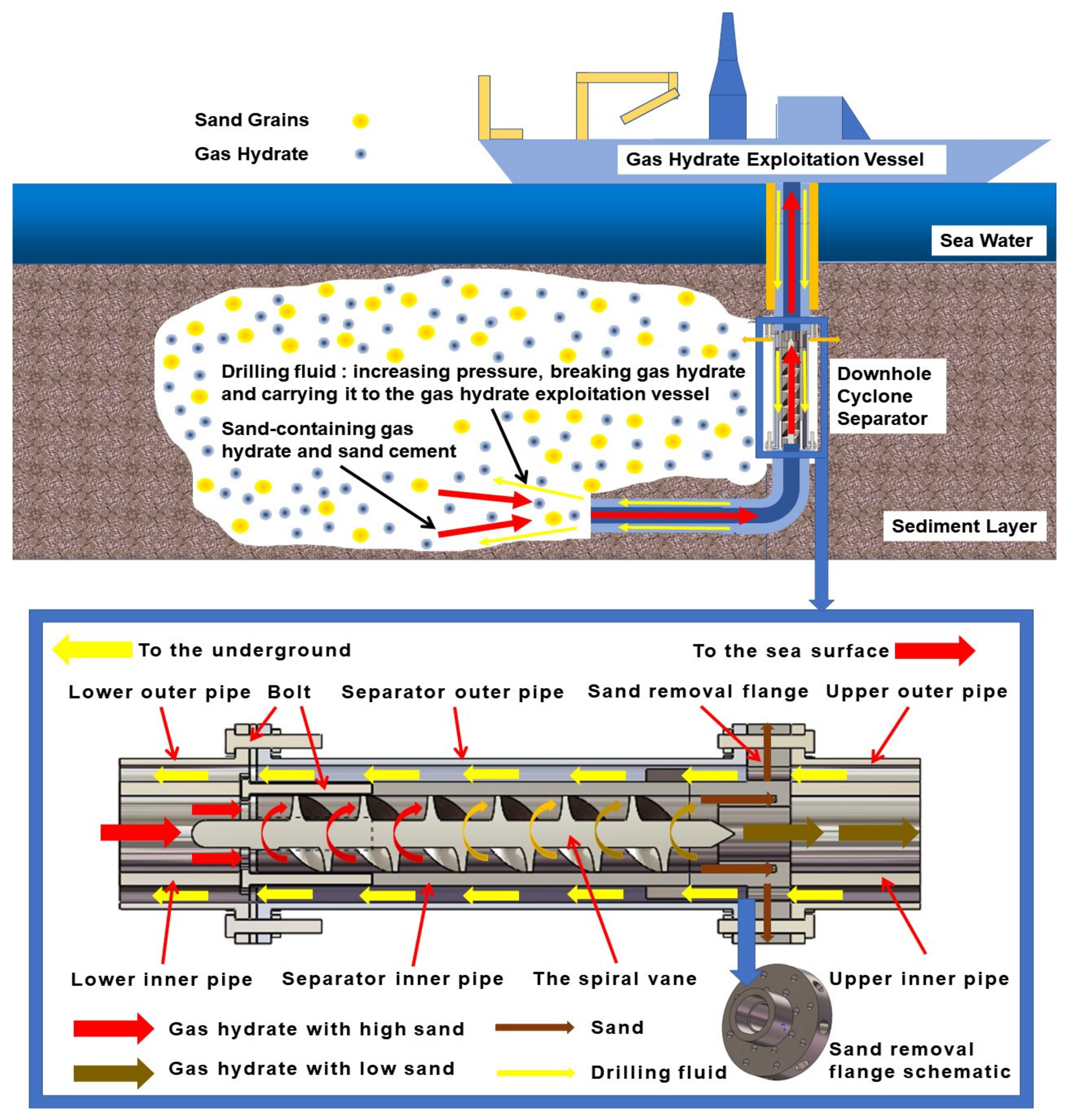
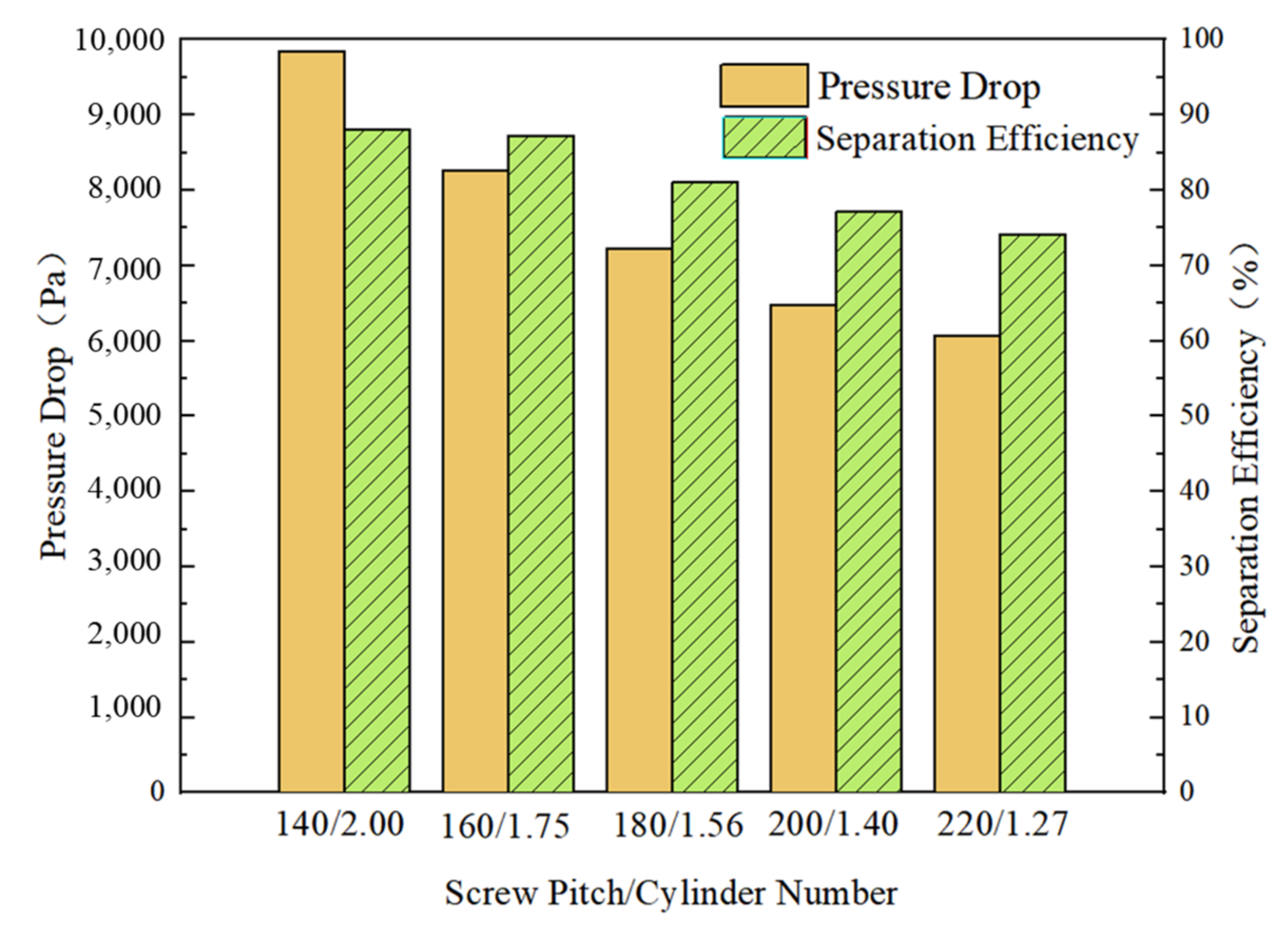
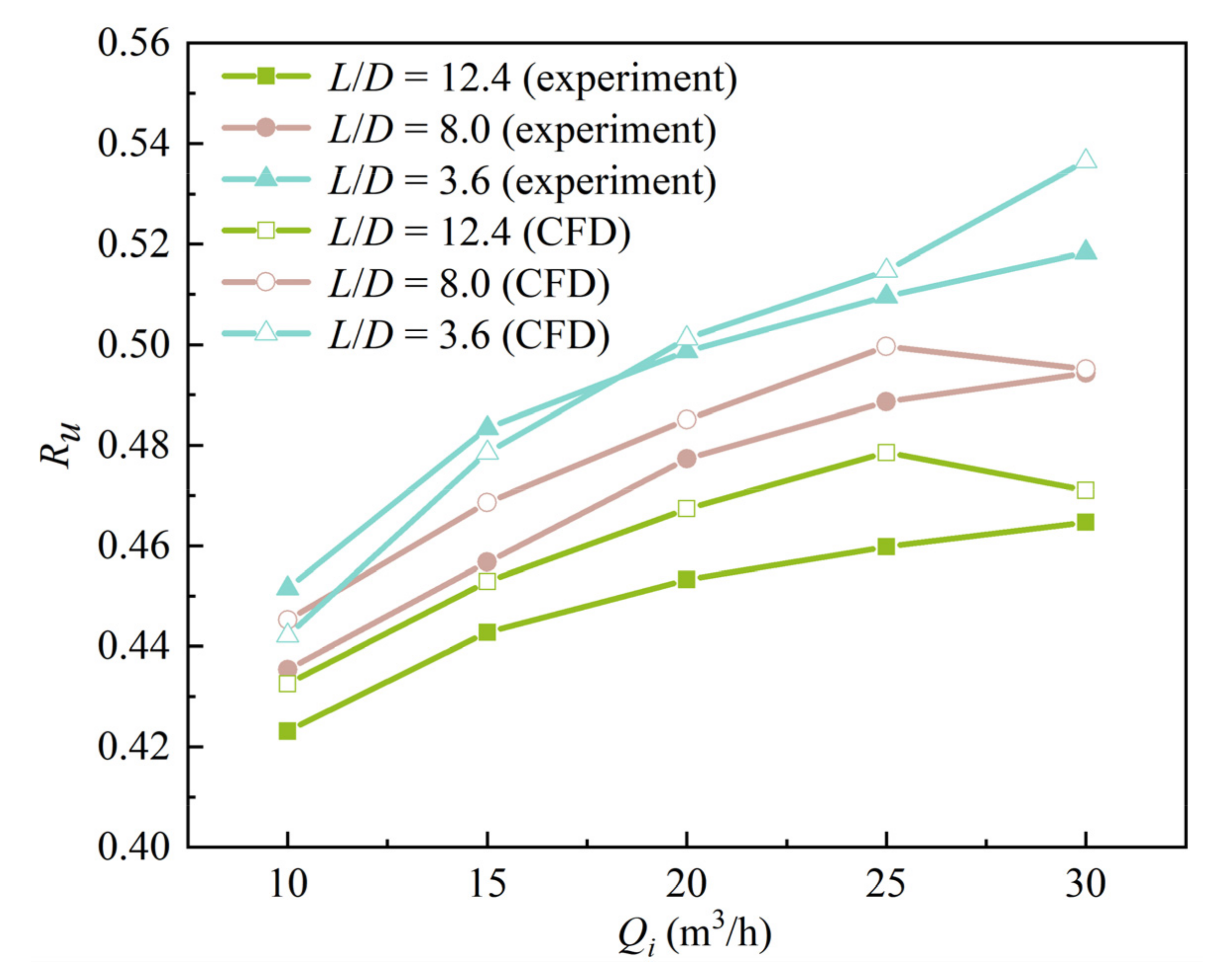
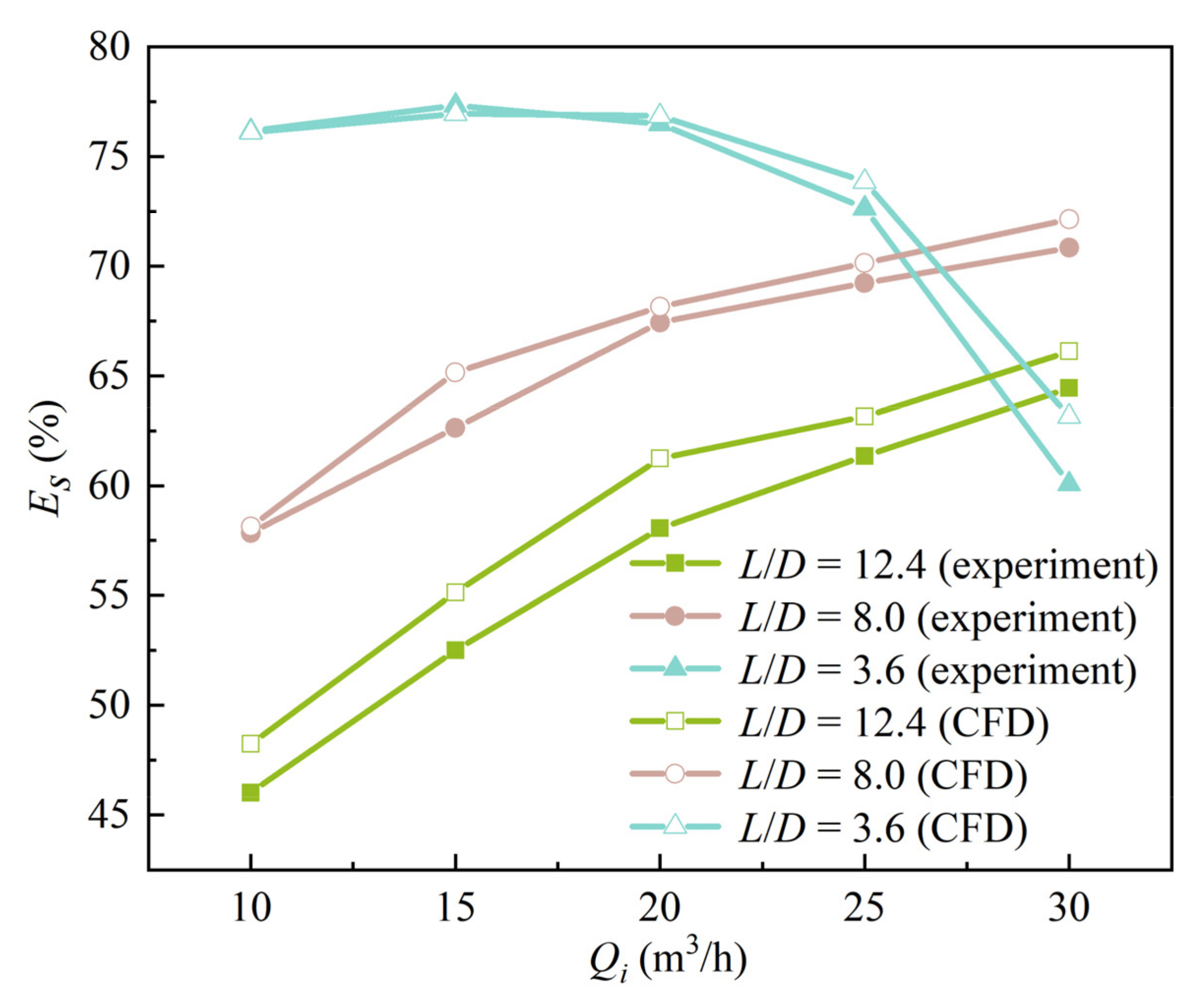
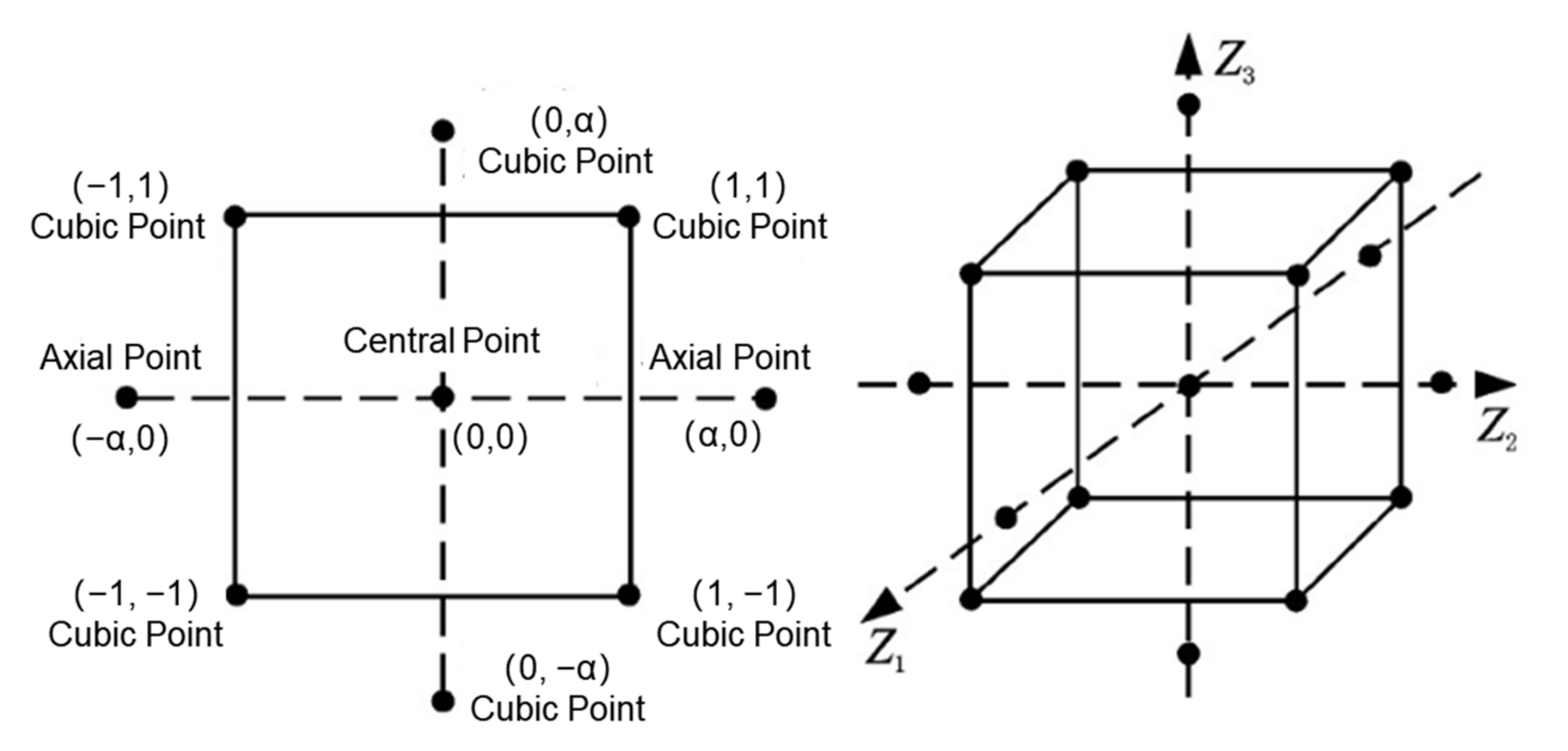
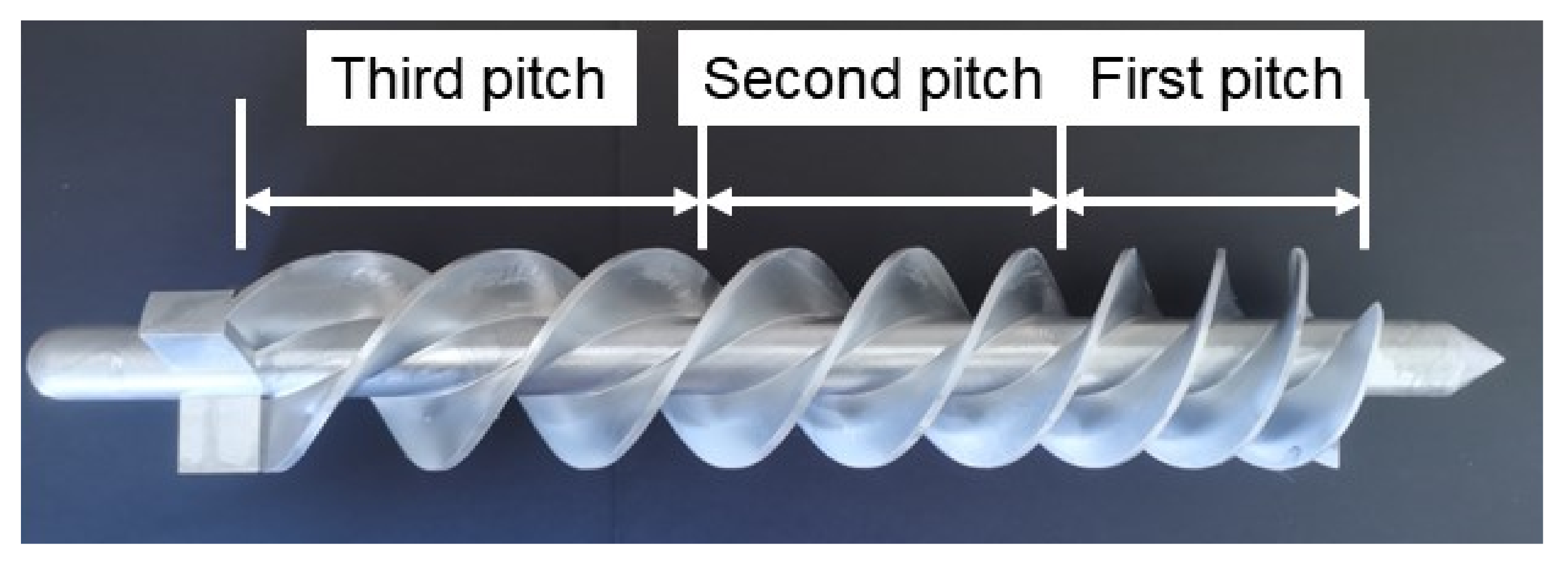
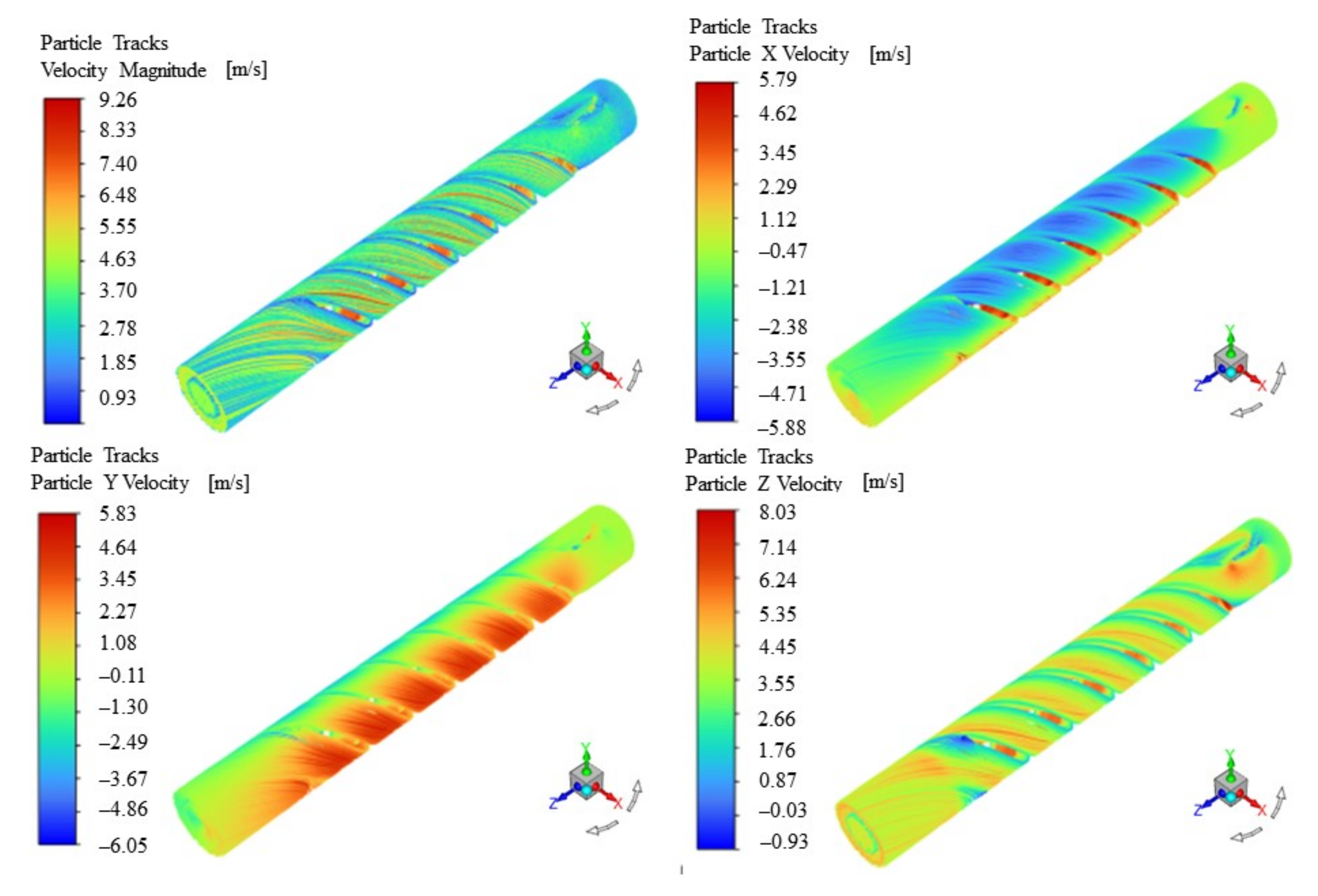

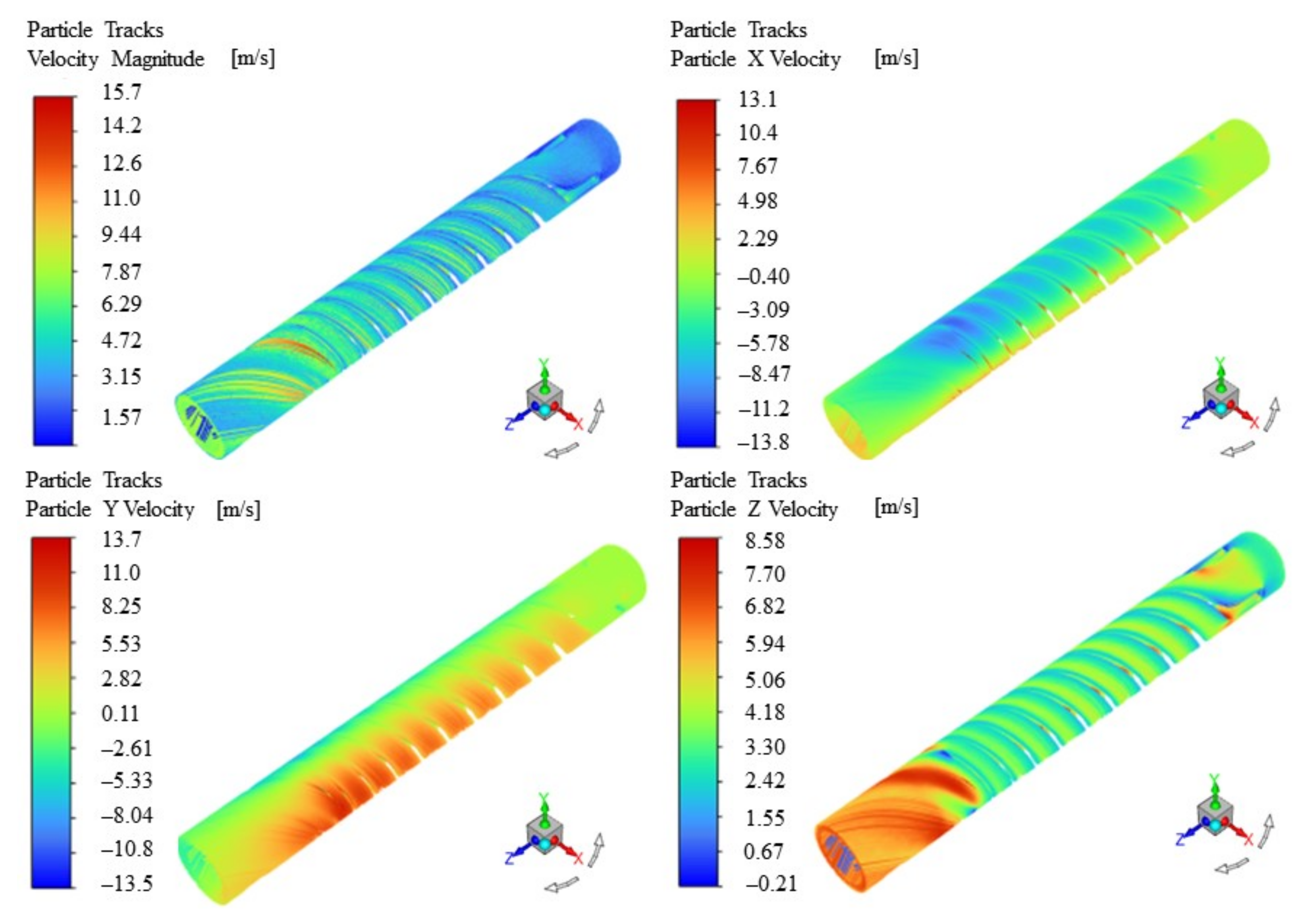
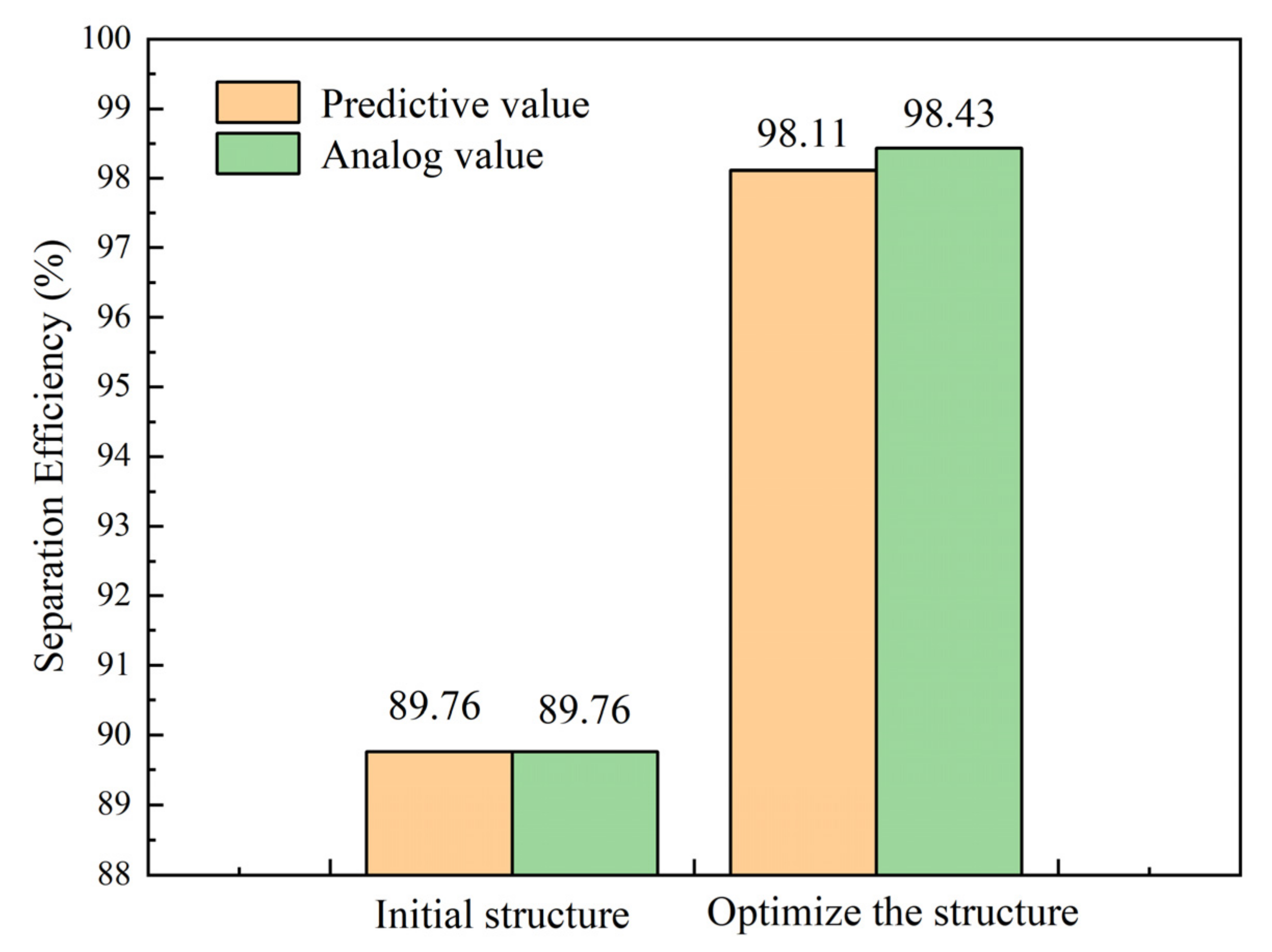
| Factor | Symbol | Level | ||
|---|---|---|---|---|
| Lower Limit (−1) | Upper Limit (1) | Center Point (0) | ||
| First pitch (mm) | x1 | 75 | 85 | 80 |
| Second pitch (mm) | x2 | 95 | 105 | 100 |
| Third pitch (mm) | x3 | 115 | 125 | 120 |
| No. | x1 | x2 | x3 | Ez | ∆p (KPa) | No. | x1 | x2 | x3 | Ez | ∆p (kPa) |
|---|---|---|---|---|---|---|---|---|---|---|---|
| 1 | 80 | 95 | 125 | 0.9763 | 56.3 | 10 | 85 | 95 | 120 | 0.9685 | 41.5 |
| 2 | 80 | 100 | 120 | 0.9728 | 44.1 | 11 | 80 | 100 | 120 | 0.9728 | 44.1 |
| 3 | 75 | 100 | 125 | 0.9785 | 44.6 | 12 | 80 | 100 | 120 | 0.9728 | 44.1 |
| 4 | 85 | 100 | 115 | 0.9699 | 23.9 | 13 | 80 | 100 | 120 | 0.9728 | 44.1 |
| 5 | 80 | 105 | 125 | 0.9821 | 28.9 | 14 | 85 | 100 | 125 | 0.9742 | 35.6 |
| 6 | 75 | 95 | 120 | 0.9785 | 44.7 | 15 | 80 | 105 | 115 | 0.9749 | 60.7 |
| 7 | 75 | 105 | 120 | 0.9720 | 37.5 | 16 | 80 | 100 | 120 | 0.9728 | 44.1 |
| 8 | 85 | 105 | 120 | 0.9713 | 62.7 | 17 | 85 | 95 | 120 | 0.9728 | 28.1 |
| 9 | 80 | 95 | 115 | 0.9728 | 9.6 |
| Source | Sum of Squares | Degrees of Freedom | Mean Square | F-Value | p-Value |
|---|---|---|---|---|---|
| y1 Model | 0.0002 | 9 | 0.0000 | 6.84 | 0.0095 |
| y2 Model | 2611.53 | 9 | 290.17 | 10.76 | 0.0025 |
| x1 | 9.68 | 1 | 9.68 | 0.3590 | 0.5679 |
| x2 | 177.66 | 1 | 177.66 | 6.59 | 0.0372 |
| x3 | 232.20 | 1 | 232.20 | 8.61 | 0.0219 |
| x1x2 | 201.64 | 1 | 201.64 | 7.48 | 0.0291 |
| x1x3 | 5.76 | 1 | 5.76 | 0.2136 | 0.6580 |
| x2x3 | 1540.56 | 1 | 1540.56 | 57.13 | 0.0001 |
| x12 | 11.64 | 1 | 11.64 | 0.4316 | 0.5322 |
| x22 | 72.95 | 1 | 72.95 | 2.71 | 0.1440 |
| x32 | 371.05 | 1 | 371.05 | 13.76 | 0.0076 |
| Residual | 188.75 | 7 | 26.96 | ||
| Lack of Fit | 188.75 | 3 | 62.92 | ||
| Cor Total | 2800.28 | 16 |
| Statistics Project | y1 | y2 | Statistics Project | y1 | y2 |
|---|---|---|---|---|---|
| Standard Deviation | 0.0016 | 5.19 | R2 | 0.8979 | 0.9326 |
| Mean | 0.9739 | 40.86 | Adjusted R2 | 0.7667 | 0.8459 |
| Coefficient of Variation (%) | 0.1665 | 12.71 | Predicted R2 | −0.6331 | −0.7785 |
| Adeq Precision | 10.5114 | 12.6455 |
Publisher’s Note: MDPI stays neutral with regard to jurisdictional claims in published maps and institutional affiliations. |
© 2022 by the authors. Licensee MDPI, Basel, Switzerland. This article is an open access article distributed under the terms and conditions of the Creative Commons Attribution (CC BY) license (https://creativecommons.org/licenses/by/4.0/).
Share and Cite
Nie, Q.; Li, M.; Zhou, S. Structural Parameter Optimization of the Helical Blade of the Variable-Pitch, Downhole, Cyclone Separator Based on the Response Surface Method. Energies 2022, 15, 6839. https://doi.org/10.3390/en15186839
Nie Q, Li M, Zhou S. Structural Parameter Optimization of the Helical Blade of the Variable-Pitch, Downhole, Cyclone Separator Based on the Response Surface Method. Energies. 2022; 15(18):6839. https://doi.org/10.3390/en15186839
Chicago/Turabian StyleNie, Qi, Meiqiu Li, and Sizhu Zhou. 2022. "Structural Parameter Optimization of the Helical Blade of the Variable-Pitch, Downhole, Cyclone Separator Based on the Response Surface Method" Energies 15, no. 18: 6839. https://doi.org/10.3390/en15186839





